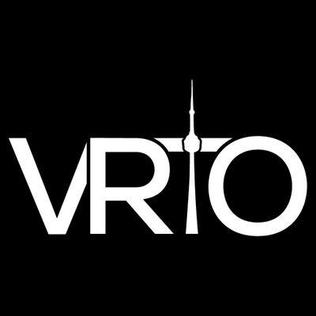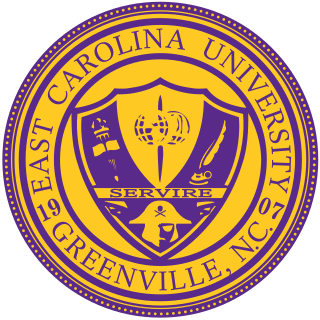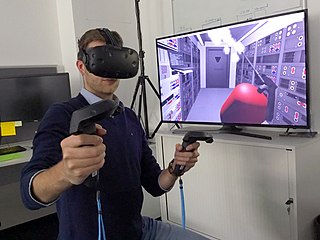Mixed reality (MR), sometimes referred to as hybrid reality, is the merging of real and virtual worlds to produce new environments and visualizations where physical and digital objects co-exist and interact in real time. Mixed reality takes place not only in the physical world or the virtual world, but is a mix of reality and virtual reality, encompassing both augmented reality and augmented virtuality via immersive technology. The first immersive mixed reality system, providing enveloping sight, sound, and touch was the Virtual Fixtures platform developed at the U.S. Air Force's Armstrong Laboratories in the early 1990s. In a study published in 1992, the Virtual Fixtures project at the U.S. Air Force demonstrated for the first time that human performance could be significantly amplified by the introduction of spatially registered virtual objects overlaid on top of a person's direct view of a real physical environment.
The Virtual Reality Applications Center (VRAC) is a research center within the Engineering Teaching and Research Complex (ETRC) at Iowa State University (ISU) and is involved in advanced research of virtual reality (VR), augmented reality (AR), human computer interaction (HCI), visualization, and is home to the world's highest resolution immersive virtual reality facility, known as the C6.
Education in Chemistry is a print and online magazine covering all areas of chemistry education, mainly concentrating on the teaching of chemistry in secondary schools and universities. It is published by the Royal Society of Chemistry, which also publishes Chemistry Education Research and Practice, a peer-reviewed academic journal on the same topic.

Brett Atwood is a website editor, content strategist and former print and online journalist whose writings have appeared in Billboard, Rolling Stone, Vibe, The Hollywood Reporter and other publications. Atwood has held managing editor positions at leading Internet sites Amazon.com, Secondlife.com and RealNetworks. In 2001, Atwood's career shifted to include academia. He is currently the director of the Integrated Strategic Communication at Everett (ISC) program and an associate professor at the Edward R. Murrow College of Communication at Washington State University. He holds an M.A. degree in communication from University of the Pacific in Stockton, California.
S. Gregory Boyd is an American author, attorney, and professor specializing in intellectual property, the game industry, and high technology media. He is currently a partner and the chairman of the Interactive Entertainment Group at Frankfurt Kurnit Klein & Selz PC and an adjunct professor for the New York Law School. He also sits on the Board of Advisors for MobyGames.

Henry Fuchs is a fellow of the American Academy of Arts and Sciences (AAAS) and the Association for Computing Machinery (ACM) and the Federico Gil Professor of Computer Science at the University of North Carolina at Chapel Hill (UNC). He is also an adjunct professor in biomedical engineering. His research interests are in computer graphics, particularly rendering algorithms, hardware, virtual environments, telepresence systems, and applications in medicine.
Gregory Peter Panos in Bronxville, New York is an American writer, futurist, educator, strategic planning consultant, conference / event producer, and technology evangelist in Augmented Reality, virtual reality, human simulation, motion capture, performance animation, 3D character animation, human-computer interaction and user experience design.
David Passig is an Israeli futurist. He specializes in technological futures, as well as social and educational futures. He is an associate professor at the Bar-Ilan University in Israel. He heads the Graduate Program in Information and Communication Technology and the Virtual Reality Laboratory at the School of Education.
Labshare consortium is a laboratory sharing initiative established by the Federal Commonwealth of Australia Government's Department of Education, Employment and Workplace Relations by their Diversity and Structural Adjustment Fund awarded the five Australian Technology Network Universities: University of South Australia, Royal Melbourne Institute of Technology, University of Technology Sydney, Curtin University of Technology and Queensland University of Technology, which supported the national sharing of remote labs as a consortium of Australian Technology Network Universities who would share remote laboratories.
Diane Gromala is a Canada Research Chair and a Professor in the Simon Fraser University School of Interactive Arts and Technology. Her research works at the confluence of computer science, media art and design, and has focused on the cultural, visceral, and embodied implications of digital technologies, particularly in the realm of chronic pain.

Palmer Freeman Luckey is an American entrepreneur and the founder of Anduril Industries, a defense technology company focused on autonomous drones and sensors for military applications. He is best known as the founder of Oculus VR and designer of the Oculus Rift, a high quality virtual reality head-mounted display that is widely credited with reviving the virtual reality industry. In 2017, owing to issues related to 2016 political contributions to Republicans and public support for then-presidential nominee Donald Trump, Luckey departed Oculus and founded defense contractor Anduril Industries. Luckey ranks #22 on Forbes' 2016 list of America's richest entrepreneurs under 40.

Carolina Cruz-Neira is a Spanish-Venezuelan-American computer engineer, researcher, designer, educator, and a pioneer of virtual reality (VR) research and technology. She is known for inventing the CAVE automatic virtual environment. She previously worked at Iowa State University (ISU), University of Louisiana at Lafayette and is currently the director of the Emerging Analytics Center at the University of Arkansas at Little Rock.

Google Cardboard is a virtual reality (VR) platform developed by Google for use with a head mount for a smartphone. Named for its fold-out cardboard viewer, the platform is intended as a low-cost system to encourage interest and development in VR applications. Users can either build their own viewer from simple, low-cost components using specifications published by Google, or purchase a pre-manufactured one. To use the platform, users run Cardboard-compatible applications on their phone, place the phone into the back of the viewer, and view content through the lenses.

Thomas A. Furness III is an American inventor, professor, and virtual reality pioneer based in Seattle, Washington. He is a Professor in the University of Washington Department of Industrial & Systems Engineering, and the founder of the Human Interface Technology Lab at the University of Washington and its sister labs at the University of Canterbury and University of Tasmania. Known for his contributions in developing human interface technology, he has earned the title, "Grandfather of Virtual Reality."

Started in 2015, as a Virtual Reality Meetup Group in Toronto, VRTO launched the VRTO Virtual & Augmented Reality World Conference & Expo in June 2016 - an international exhibition and professional conference exploring arts, culture and science through immersive technologies. Its inaugural year - held at the Mattamy Centre - featured keynotes from University of Toronto Professor Steve Mann, Hollywood film director Brett Leonard - director of The Lawnmower Man, Chief Digital Officer Ana Serrano of the Canadian Film Centre and Phil Lelyveld of USC.

Shafi Ahmed is a surgeon, teacher, futurist, innovator and entrepreneur.
X Reality is defined as: a form of “mixed reality environment that comes from the fusion (union) of ... ubiquitous sensor/actuator networks and shared online virtual worlds....”. It encompasses a wide spectrum of hardware and software, including sensory interfaces, applications, and infrastructures, that enable content creation for virtual reality (VR), mixed reality (MR), augmented reality (AR), cinematic reality (CR). With these tools, users generate new forms of reality by bringing digital objects into the physical world and bringing physical world objects into the digital world.
Applications of VR can be found in fields as diverse as entertainment, marketing, education, medicine, construction and road safety training and many others. They provide numerous possibilities for users to explore virtual realities for various purposes.









